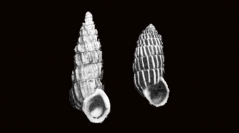

 Comptes Rendus Palevol
2 (6-7) - Pages 435-453
Comptes Rendus Palevol
2 (6-7) - Pages 435-453From 1962 to the end of his career, Stephen Jay Gould has studied the land snails of the genera Poecilozonites and then Cerion. Snails have provided him material to develop his morphometric methods, to analyze shell growth, and may have been at the origin of his work on ontogeny and phylogeny. Their variation, which he interpreted in terms of adaptation until the beginning of the 1980s, has been later reanalyzed by him in terms of non-adaptive evolution and contingency. Growth and variation of the shell allowed Gould to define constraint and canalisation in evolution. In their taxonomic work, Gould and Woodruff have practiced a definition of biological species as the group of populations allowing maximal congruence of their morphological characters, genetic characters and geographic distribution, of which potential interfecundity is necessary, but not sufficient.
Gastropoda, Gould, evolution, taxonomy, ontogeny, adaptation, punctuated equilibria, species concept